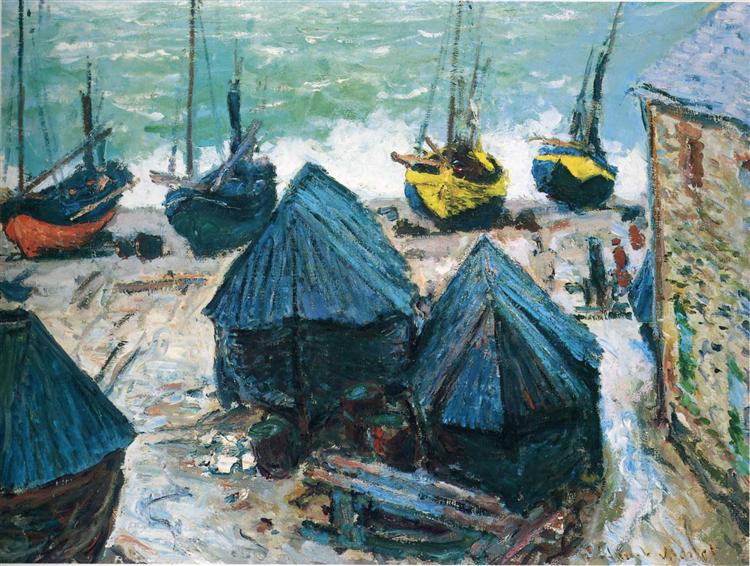Description
The work "Boats on the beach of Meatat" (1885) by Claude Monet is part of the context of impressionism, an artistic movement that broke with academic conventions, prioritizing the subjective perception of the landscape and the effects of light. The painting transports us to the coast of Meetretat, a place that Monet frequented and inspired by multiple occasions throughout his career. In this work, the ocean becomes the pretext to explore the vibrant interaction between light, color and shape.
At first glance, the composition is organized predominantly around a coastal landscape where several boats rest in the sand. The boats, in tones of white and blue, are aligned on the shore, almost anchored to the beach, suggesting moments of rest after an effort in the sea or perhaps waiting for the next adventure. The texture of the paint is explicit and rich, a testimony of the monet style that uses loose and dynamic brushstrokes, transmitting both the movement of water and the breeze that caresses the beach.
The colors that Monet chooses for this work are particularly significant. The palette is characterized by a sophisticated combination of blue, greenish, and ivory that evoke the calm of the sea and the clarity of the sky, as well as the golden sand of the beach. In this sense, Monet does not simply reproduce reality, but interprets it, seeking to capture the essence of the moment, that fleeting moment in which the light mixes with the environment. We also appreciate a subtle air treatment, which is felt through the contrasts of light and shadow.
While the work lacks human figures on a considerable scale, its absence enhances the connection between ships and the surrounding landscape. This void suggests a contemplation space, where the viewer is free to imagine life on the beach, filling the holes with their own experiences and memories. The silhouettes of the boats stand out against the clear background, as symbols of human activity in a natural place, reflecting the spirit of Monet's time, who valued the connection between man and his surroundings.
"Boats on the beach of Étretat" is a remarkable example of Monet's trend to capture the changing light and the atmosphere of its landscapes. In the context of its production in 1885, this work is aligned with other representations of the same town, where the formations of cliffs of Étretat and the sea are characters in themselves. Monet, in this sense, seeks not only to capture a visual moment, but also evoke the feeling of the landscape itself, turning the canvas into a scenario of modern interactions between the nature and work of man.
The interest in this piece is not only artistic, but also contextual. Monet painted this work during a time when he was developing his style and experiencing with the light and color of innovative ways. It was a period where new ways of seeing the world were establishing, where individual perception defined the aesthetic experience. Thus, "ships on the beach of Meettat" is inserted in a broader dialogue on the role of the artist in the modernity and role of the viewer in the art experience.
In conclusion, "Boats on the beach of Meter" is a work that encapsulates not only Monet's technical mastery, but also its deep emotional connection with the landscape. Through the combination of a vibrant color palette, attention to detail in texture and brilliant light interpretation, Monet offers a shelter that invites you to contemplate the ephemeral beauty of the natural world and human intervention in it, establishing a milestone in The path of impressionism.
KUADROS ©, a famous paint on your wall.
Hand-made oil painting reproductions, with the quality of professional artists and the distinctive seal of KUADROS ©.
Reproduction service paintings With a guarantee of satisfaction. If you are not completely satisfied with the replica of your painting, we refund your money 100%.

